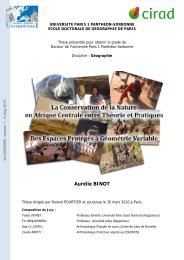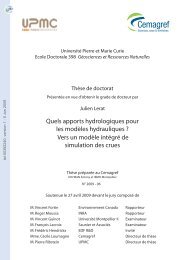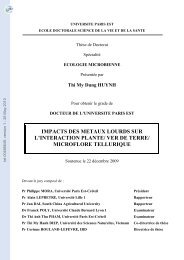Protocols for field and laboratory rodent studies - HAL
Protocols for field and laboratory rodent studies - HAL
Protocols for field and laboratory rodent studies - HAL
- No tags were found...
You also want an ePaper? Increase the reach of your titles
YUMPU automatically turns print PDFs into web optimized ePapers that Google loves.
<strong>Protocols</strong> <strong>for</strong> <strong>field</strong> <strong>and</strong> <strong>laboratory</strong> <strong>rodent</strong> <strong>studies</strong>Recommendations:When h<strong>and</strong>ling traps, wear thick rubber gloves. Keep in the car some gloves boxes, soap,disinfectant <strong>and</strong> water to wash h<strong>and</strong>s whenever required.Transport the captured animals in cars, outside of the passenger section. A pickup car may bepreferred so that the cages are placed at the rear of the car. This area should be ventilated by openingthe windows if a hardtop is present.Protect animals from the sun <strong>and</strong> the heat. Do not pile cages up.Carefully wash <strong>and</strong> disinfect the car, once the traps have been unloaded.1.2. Trapping protocolTrapping <strong>rodent</strong>s <strong>for</strong> medical or ecological researches requires a trapping protocol to be defined. The descriptionof this protocol is necessary to evaluate the success <strong>and</strong> the representativeness of the trapping. This protocolshould be set up according to the objectives of the study. A certain minimum number of animals are generallyrequired to assess the prevalence of pathogens or to investigate population genetics <strong>and</strong> morphometrics.However, it is very important to realize that <strong>rodent</strong> populations are seasonally heterogeneous in respect of agestructure <strong>and</strong> breeding status, <strong>and</strong> consequently <strong>for</strong> various infection parameters that depend on the functionalgroup of the host individual. Reliable comparisons can be made only between same functional groups.Multiannual differences in infection parameters may depend of differences in age structure, not on differencesbetween comparable units, functional groups.The trapping system <strong>and</strong> intensity should be similar at each sampling site in order to avoid biases whencomparing the <strong>rodent</strong> communities between habitats <strong>and</strong> localities.When targeting the diversity of <strong>rodent</strong>, the trapping protocol should take into account the l<strong>and</strong>scape features. Onesimple way is to categorize the l<strong>and</strong>scape into main categories (stratified sampling) <strong>and</strong> then to manage equaltrapping pressures in each of them. In South-East Asia, we have distinguished four main l<strong>and</strong>scape categories,further divided in sub-units, <strong>for</strong> the CERoPath trapping protocol. This may be adapted in other regions:1- Built-up areas: villages <strong>and</strong> isolated houses;2- Flood plains (humid or irrigated areas): alternating paddy cultivation <strong>and</strong> pasture in the rainfall farmingsystems or more complex rotations including legumes (soy bean, mung bean, peanut) <strong>and</strong> cash crops(paddy, vegetables, maize) in irrigated systems;3- Dry l<strong>and</strong>s: including annual (maize, dry rice), multi annual (cassava, grassl<strong>and</strong>, pineapple), perennial(orchards <strong>and</strong> young bamboo, teak, young plantations of rubbers <strong>and</strong> eucalyptus), cultivated areas <strong>and</strong>fallow l<strong>and</strong>s covered by grasses <strong>and</strong> shrubs;4- Wooded areas: including <strong>for</strong>ests (deciduous dipterocarp, mixed deciduous <strong>and</strong> evergreen <strong>for</strong>est), <strong>and</strong>mature plantations (bamboo, teak, rubber tree, eucalyptus…).This typology is very simple from an ecological point of view but it allows a description of the major <strong>rodent</strong>habitats.The organization of the trapping using several lines of traps is generally used to have a clear <strong>and</strong> reproducibleprotocol with a calculable trapping pressure. We recommend composing each line with 10 traps, placed every 5-10 meters. These lines should be retained <strong>for</strong> 3-5 nights at the same locality. We also recommend sampling eachof the l<strong>and</strong>scape categories using several trap-lines (10 to 20 lines). The duration of the setting of the trap-lines isa compromise between too much mobility (where the <strong>rodent</strong>s do not have the opportunity to encounter the traps<strong>and</strong> to get used to them) <strong>and</strong> too much stability (where the majority of animals are removed from the area by thetrapping, leading to a decrease in the trapping success over time). This trapping system will hopefully provide agood representation of the <strong>rodent</strong> diversity <strong>and</strong> community structures <strong>and</strong> take into account the variation withinthese l<strong>and</strong>scape categories. However, we acknowledge that there are many other methods, <strong>and</strong> we recommendadopting this method according to the environment <strong>and</strong> the aim of the study.To be accepted by local people (<strong>and</strong> in order to limit trap removal or displacement), the owner of the <strong>field</strong> shouldbe contacted be<strong>for</strong>e setting the traps. In order to facilitate the daily control <strong>and</strong> the trap recovery, each trap shouldbe marked by a piece of surveyor’s flagging attached at proximity (i.e. 1-2 m) in the vegetation (being aware that itmay increase the danger of traps to be stolen). A unique code is attributed to each trap line. Trap lines arelocalized using their centre with the geographical coordinates given by a GPS receiver.Local hunters can help with the acquisition of additional animals. This has proven efficient in South-East Asia,where rats are often hunted <strong>for</strong> food. Hunters have a great knowledge of rat ecology <strong>and</strong> they can catch manyanimals each night. Farmers are also helpful because they notice the presence <strong>and</strong> the abundance of rats byobserving their tracks <strong>and</strong> the state of their holes in the edge of <strong>field</strong>s. Usually farmers can in<strong>for</strong>m if <strong>rodent</strong>s arepresent or not in their <strong>field</strong>. However they may not know about small-size <strong>rodent</strong>s. They also may provide anegative answer if they are against any intrusion in their <strong>field</strong>s.4
















